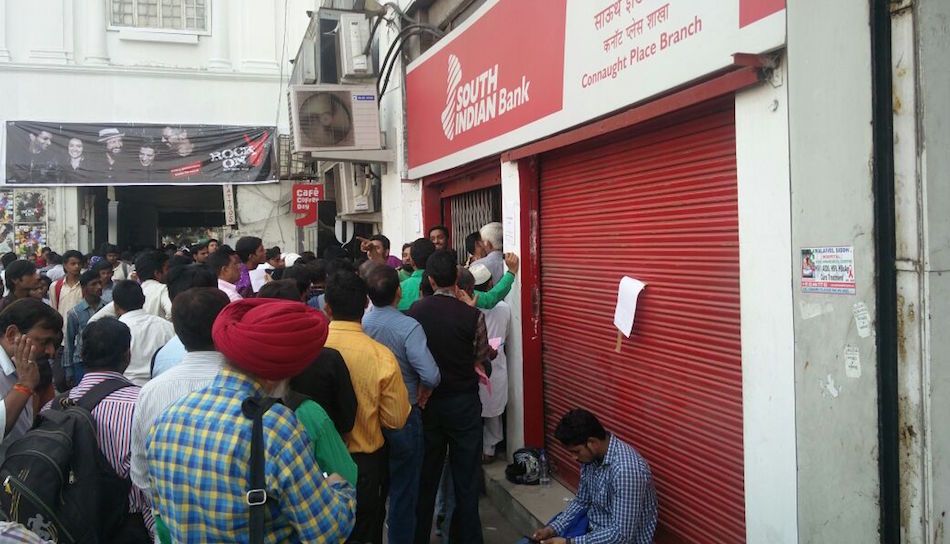
Photo credit: sifotography / 123RF.
Long before demonetization and a scramble to find alternatives to cash, India had laid out a unique tech infrastructure for a digital economy. Its cornerstones were a unique biometrics-based Aadhaar ID for every citizen to enable authentication, and a unified payments interface (UPI) to simplify money transfer.
India is on the cusp of leapfrogging.
It’s called “India stack.” Tech evangelists helped put it together, and it includes other digital enablers like eSign and a digital locker, all backed by government and the Reserve Bank of India (RBI). Bill Gates was so impressed with it on a recent visit that he exclaimed: “India is on the cusp of leapfrogging!”
But leapfrogging only happens with mass adoption. Although Aadhaar had identified and authenticated a billion Indians, and UPI made mobile payments as simple as sending a message or mail, banks dragged their feet over it.
Slip between the cup and the lip
The National Payments Corporation of India (NPCI) – an umbrella organization set up by the Reserve Bank of India (RBI) – formally launched the UPI in April to ease mobile payments in the world’s fastest growing smartphone market.
Banks adopting it could assign a virtual address linked to a unique number to every customer who opts in – such as sumit@yesbank.com. All you need for a payment or money transfer then is this address – no need for account number, IFSC code, adding beneficiary details, and so on. It’s also easier than card payments and merchants wouldn’t need card-swiping machines.
The infrastructure for mobile payments was already built. It needed entrepreneurs to take it to consumers.
For it to work, however, both parties in a transaction need virtual addresses, and that would be more likely with widespread adoption of UPI-powered bank apps.
Less than 30 banks out of the 150 odd that were eligible signed up for it when the UPI launched in April, and some major banks were conspicuous by their absence. Some of them started rolling out their UPI apps in August, but they didn’t go out of their way to evangelize its adoption by customers.

Queues snaking out of banks have been a common sight across India for weeks. Photo credit: Harsimran Julka.
Come November, India put a crimp in cash transactions by suddenly banning high-denomination currency notes and limiting cash withdrawals. One would have expected this to be the moment when people turn to the bank apps using UPI. Instead, they flocked to the more user-friendly and familiar digital wallets for mobile payments. Paytm started getting half a million new users each day to reach a user base of 165 million today.
The Paytm tipping point
Now comes the game-changer. Paytm has a payments bank coming up shortly. This is a new entity created in India where a bank is restricted to payments – that is, it can’t convert deposits into bank loans. Telecom major Airtel was the first to launch a payments bank last month. Others with licences “in principle” from RBI, including Paytm, are expected to follow.
Paytm has already announced that its digital wallet will be merged with the payments bank, which will enable transactions up to INR 100,000 (US$1481). Existing wallet users will automatically get bank accounts, but they will need to do a KYC (know your customer) to make payments through the bank. The KYC will mostly happen through the Aadhaar ID.

Vijay Shekhar Sharma, founder and CEO of Paytm. Photo credit: Tech in Asia.
This is the truest opportunity to build something designed for unique Indian needs.
Now, like the conductor of a symphony orchestra, Paytm founder and CEO Vijay Shekhar Sharma is making his next overture. He announced this week that the Paytm payments bank will be integrated with everything in the India stack, including UPI, Aadhaar, eSign, and digital locker.
Essentially, this will make Paytm interoperable with any bank which is part of the UPI. As of now, a transaction requires both parties to be Paytm users. Once it has a UPI-powered app, a Paytm customer with a virtual address – such as sumit@paytm.com – can send money to anybody with a virtual address from some other bank and vice versa.
Other wallets in India, like FreeCharge (acquired by Snapdeal) and Mobikwik, have developed UPI-powered apps in partnership with banks. PhonePe, a payments startup acquired by ecommerce leader Flipkart, has a UPI app in partnership with YesBank. But Paytm wants to have its own app, because it will have a licence to run a payments bank, and can give its customers an @paytm virtual address.
It’s a tipping point for UPI. Traditional banks may have dragged their feet over onboarding users. But there will be no such lack of agility when mobile-first players like Paytm get into the act.
See: Here’s an example of India leading the world in tech infrastructure
Race to build the best UPI app
Apart from the 165 million wallet users currently, Paytm has signed up 4 million merchants, including a million who have done the KYC required for larger storage and transactions. These include many offline small retailers and service providers who use the QR code scanning option for receiving payments that Paytm introduced last year.
Vijay Shekhar Sharma expects to have 10 million merchants on board by year-end, with the spike in demand coming from a cash crunch. The real figure may actually be much larger because many shopkeepers use their individual Paytm accounts and don’t register themselves as merchants.
The process might have taken three to six years. Demonetization will accelerate it to three to six months.
To a question from Tech in Asia on how the Paytm app will be different from UPI-powered apps by traditional banks, Vijay Shekhar Sharma pointed immediately to customer experience. “Banks are not great at rolling out UPI,” he said. But for Paytm, “this is the truest opportunity to build something designed for unique Indian needs.”
The India stack also fits in well with Paytm’s plans for financial services riding on its massive payments user base and data. “I can help a shopkeeper with loans with his payment records. I can upsell a product like insurance or provide wealth management… I don’t know what solution we’ll come up with tomorrow… We’re like ether,” he told Tech in Asia in an interview a few days before announcing the integration with UPI.
See: Paytm founder prepares for his biggest pivot
Multiplier effect
Sharad Sharma, co-founder of industry think tank iSPIRT and one of the brains behind the India stack, is happy to see the rapid change from half-hearted adoption to a competition to be the most widely used UPI app.
Sharad, who is part of a committee formed by Indian prime minister Narendra Modi to enable digital payments, says the infrastructure for it was already built, but it needed “entrepreneurs like Vijay to take it to consumers.” He likens UPI to the SMTP (Simple Mail Transfer Protocol) that powers email. Paytm is to UPI what gmail is to SMTP.
Another India stack builder, Infosys co-founder Nandan Nilekani, sees a huge acceleration in its adoption as entrepreneurs push the transformation to a digital economy. “The process might have taken three to six years, but demonetization will accelerate it to three to six months,” he says.
Every brand caters primarily to the top 50 million families in the country; we’re at the cusp of bringing another 100 million families into the picture.
Nandan was chairman of the Unique Identification Authority of India in the previous Congress government that created Aadhaar. He contested a parliamentary seat and lost to a member of the current BJP government. But that didn’t stop Modi from roping him into the digital payments committee. It’s all hands on board in this massively transformative phase.
Sharad puts into perspective the economic changes that come with financial inclusion. “Every brand caters primarily to the top 50 million families in the country; we’re at the cusp of bringing another 100 million families into the picture.”
See: Why India took such a drastic step to go cashless
These 400-500 million who come into the formalized economy will leave a digital trail. Institutional credit will become available to them. Their consumption patterns will change. And that could have a multiplier effect on the economy.
The sudden demonetization and unpreparedness of the banking system to handle it have caused a lot of pain across the country, especially to the cash-dependent rural population and lower strata of society. But hopefully, tech entrepreneurs and evangelists will help turn the short-term pain to long-term gain for the country on the whole.
This post https://www.techinasia.com/mobile-payments-enabler-lukewarm-response-months-race-adopt appeared first on Tech in Asia.
from Tech in Asia https://www.techinasia.com/mobile-payments-enabler-lukewarm-response-months-race-adopt
via IFTTT
No comments:
Post a Comment